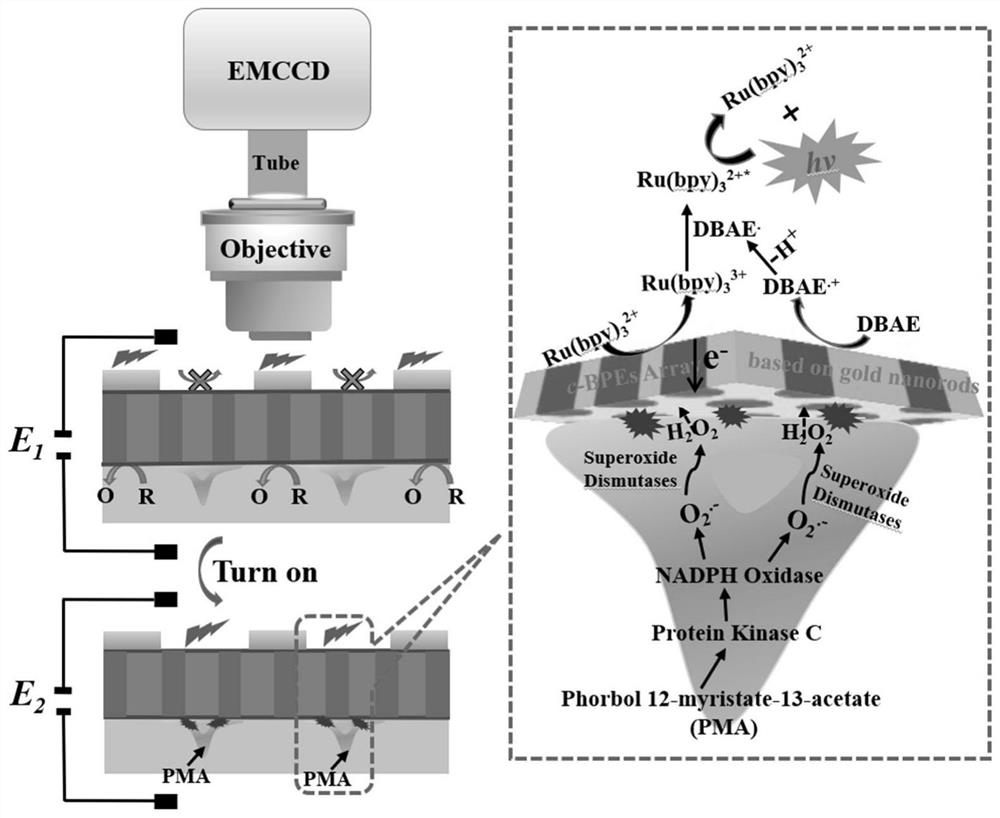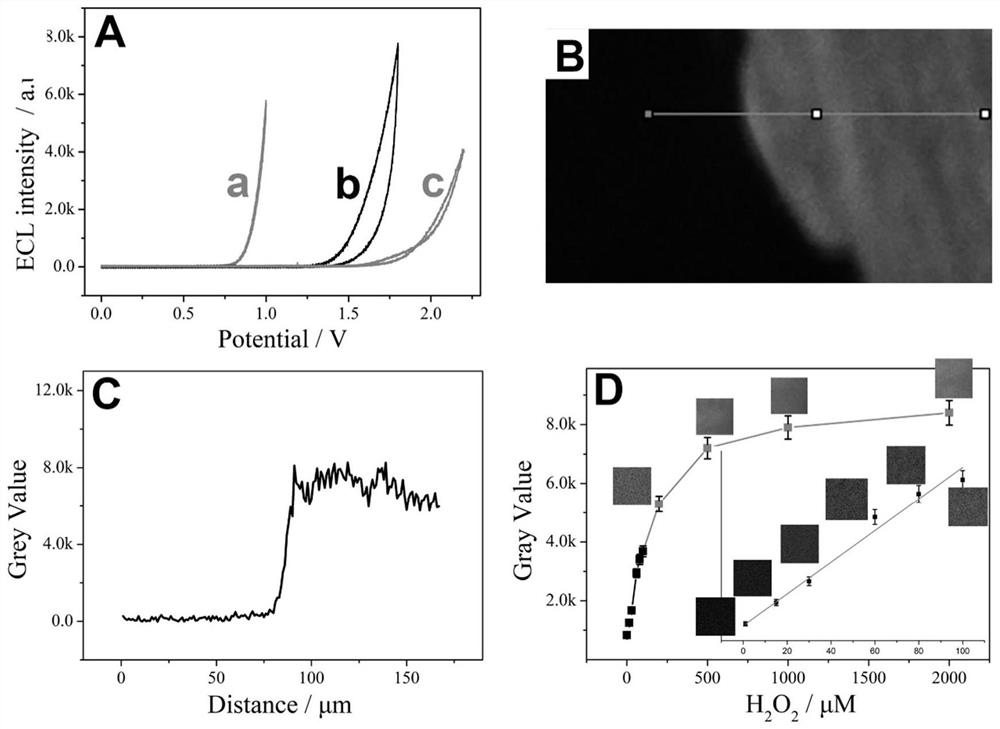Real-time in-situ quantitative analysis method for hydrogen peroxide based on bipolar nano-electrode array
A nano-electrode array, hydrogen peroxide technology, applied in the field of biosensing, can solve the problems of insufficient sensitivity, low sensitivity, expensive instruments, etc., and achieve the effects of avoiding mutual interference, improving sensitivity, and easy operation
- Summary
- Abstract
- Description
- Claims
- Application Information
AI Technical Summary
Problems solved by technology
Method used
Image
Examples
Embodiment 1
[0030] Embodiment 1: the preparation of gold nanoelectrode array
[0031] Using the template-assisted electrodeposition method, gold nanoelectrode arrays were obtained. Briefly, anodized aluminum oxide (AAO) was used as a template, which was mounted on a specific holder as a working electrode. Before electrodeposition, a thin silver film with a thickness of ~1 μm was evaporated on one side of the AAO film by electron beam vapor deposition (Kurt J. Lesker). In containing 25g / L chloroauric acid solution, 80g / L triammonium citrate, 150g / L anhydrous sodium sulfite (Na 2 SO 3 ) and 60g / L ethylenediaminetetraacetic acid (EDTA) self-made electrolyte, using repeated chronopotentiometry at 8.512mA / cm 2 Gold nanoelectrode arrays were obtained at a constant current density. Electrodeposition experiments were carried out in a conventional three-electrode system, Hg / Hg 2 SO4 electrode and platinum electrode were used as reference electrodes, and Reference600 constant current potentios...
Embodiment 2
[0032] Example 2: Cell Culture
[0033] HeLa cells (human cervical cancer cells) were cultured in Dulbecco's Modified Eagle Medium (DMEM) supplemented with 1% penicillin, 1% streptomycin and 10% fetal bovine serum at 37°C, containing 5% CO 2 . LO2 cells (normal hepatocytes) were cultured in RPMI-1640 medium containing 10% fetal bovine serum, 1% penicillin and 1% streptomycin.
[0034] First, pre-polish, clean and sterilize the nano-electrode array, then add 20 microliters of polylysine solution (PLL, 1 mg / mL) to one side of the gold nano-electrode array to promote cell adhesion and growth, and incubate at 37 ° C for 2 h Finally, digest the cells from the culture dish with trypsin, collect by centrifugation, and take a certain amount of suspension in fresh medium. A portion of the cell suspension was then added to one end of the gold nanoelectrode array. Finally, they were incubated in an incubator for 8 h for subsequent experiments.
Embodiment 3
[0035] Example 3: Principle Verification
[0036] 1) First, verify that the bipolar electrode system constructed by the gold nanoelectrode array is used to realize the photoelectric conversion function. Add (a) 5mM potassium ferricyanide, (b) 5μM hydrogen peroxide, and (c) PBS (0.01M, pH 7.0) solution to the cathode end of the bipolar electrode, and add a luminescent system (ruthenium bipyridine, 1mM Ru(bpy) 3 2+ ) and co-reactant (dibutylaminoethanol, 20mM DBAE), potassium ferricyanide is obtained by cyclic voltammetry, and the reduction potentials of hydrogen peroxide and water are respectively 1.0V, 1.8V and 2.2V, and at this potential, A stronger electrochemiluminescent signal was obtained. The results show that the photoelectric conversion can be effectively realized by using the gold nanoelectrode array. See image 3 a.
[0037] 2) Secondly, it is verified that the gold nanoelectrode array can be further used in the imaging of experimental electrochemiluminescence....
PUM
| Property | Measurement | Unit |
|---|---|---|
| diameter | aaaaa | aaaaa |
| diameter | aaaaa | aaaaa |
| diameter | aaaaa | aaaaa |
Abstract
Description
Claims
Application Information
 Login to View More
Login to View More - R&D
- Intellectual Property
- Life Sciences
- Materials
- Tech Scout
- Unparalleled Data Quality
- Higher Quality Content
- 60% Fewer Hallucinations
Browse by: Latest US Patents, China's latest patents, Technical Efficacy Thesaurus, Application Domain, Technology Topic, Popular Technical Reports.
© 2025 PatSnap. All rights reserved.Legal|Privacy policy|Modern Slavery Act Transparency Statement|Sitemap|About US| Contact US: help@patsnap.com



